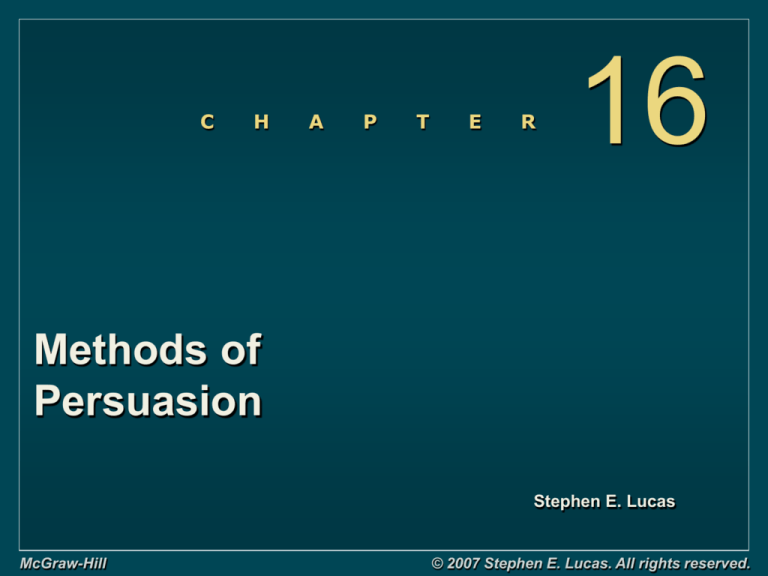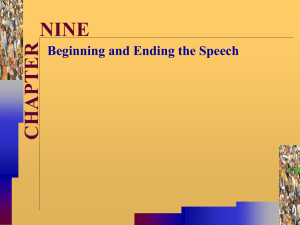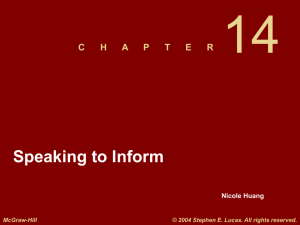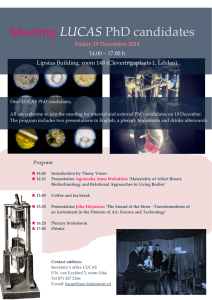
C
H
A
P
T
E
R
16
Methods of
Persuasion
Stephen E. Lucas
McGraw-Hill
© 2007 Stephen E. Lucas. All rights reserved.
Slide 2
Methods of Persuasion
•
•
•
•
McGraw-Hill
Building credibility
Using evidence
Reasoning
Appealing to emotions
© 2007 Stephen E. Lucas. All rights reserved.
Slide 3
Credibility
The audience's perception of whether
a speaker is qualified to speak on a
given topic.
McGraw-Hill
© 2007 Stephen E. Lucas. All rights reserved.
Slide 4
Ethos
The name used by Aristotle for what
modern students of communication
refer to as credibility.
McGraw-Hill
© 2007 Stephen E. Lucas. All rights reserved.
Slide 5
Factors of Credibility
• Competence
• Character
McGraw-Hill
© 2007 Stephen E. Lucas. All rights reserved.
Slide 6
Competence
How an audience regards a
speaker’s intelligence,
expertise, and knowledge of
the subject.
McGraw-Hill
© 2007 Stephen E. Lucas. All rights reserved.
Slide 7
Character
How an audience regards a
speaker’s sincerity, trustworthiness,
and concern for the well-being of the
audience.
McGraw-Hill
© 2007 Stephen E. Lucas. All rights reserved.
Slide 8
Types of Credibility
• Initial
• Derived
• Terminal
McGraw-Hill
© 2007 Stephen E. Lucas. All rights reserved.
Slide 9
Initial Credibility
The credibility of a speaker before
she or he starts to speak.
McGraw-Hill
© 2007 Stephen E. Lucas. All rights reserved.
Slide 10
Derived Credibility
The credibility of a speaker produced
by everything she or he says and
does during the speech.
McGraw-Hill
© 2007 Stephen E. Lucas. All rights reserved.
Slide 11
Terminal Credibility
The credibility of a speaker at the end
of the speech.
McGraw-Hill
© 2007 Stephen E. Lucas. All rights reserved.
Slide 12
Tips for Enhancing Credibility
• Explain your competence
• Establish common ground with
your audience
• Deliver your speeches fluently,
expressively, and with conviction
McGraw-Hill
© 2007 Stephen E. Lucas. All rights reserved.
Slide 13
Logos
The name used by Aristotle for the
logical appeal of a speaker. The two
major elements of logos are evidence
and reasoning.
McGraw-Hill
© 2007 Stephen E. Lucas. All rights reserved.
Slide 14
Evidence
Supporting materials used to prove
or disprove something.
McGraw-Hill
© 2007 Stephen E. Lucas. All rights reserved.
Slide 15
Tips for Using Evidence
•
•
•
•
Use specific evidence
Use novel evidence
Use evidence from credible sources
Make clear the point of your evidence
McGraw-Hill
© 2007 Stephen E. Lucas. All rights reserved.
Slide 16
Reasoning
The process of drawing a conclusion
on the basis of evidence.
McGraw-Hill
© 2007 Stephen E. Lucas. All rights reserved.
Slide 17
Four Types of Reasoning
•
•
•
•
McGraw-Hill
Reasoning from specific instances
Reasoning from principle
Causal reasoning
Analogical reasoning
© 2007 Stephen E. Lucas. All rights reserved.
Slide 18
Reasoning from Specific
Instances
Reasoning that moves from particular
facts to a general conclusion.
McGraw-Hill
© 2007 Stephen E. Lucas. All rights reserved.
Slide 19
Guidelines for Reasoning from
Specific Instances
• Avoid hasty generalizations
• If your evidence does not justify a
sweeping conclusion, qualify your
argument
• Reinforce your argument with
statistics or testimony
McGraw-Hill
© 2007 Stephen E. Lucas. All rights reserved.
Slide 20
Reasoning from Principle
Reasoning that moves from a general
principle to a specific conclusion.
McGraw-Hill
© 2007 Stephen E. Lucas. All rights reserved.
Slide 21
Guidelines for Reasoning
from Principle
• Make sure listeners will accept your
general principle
• Provide evidence to support your
minor premise
McGraw-Hill
© 2007 Stephen E. Lucas. All rights reserved.
Slide 22
Causal Reasoning
Reasoning that seeks to establish
the relationship between causes
and effects.
McGraw-Hill
© 2007 Stephen E. Lucas. All rights reserved.
Slide 23
Guidelines for Causal
Reasoning
• Avoid the fallacy of false cause
• Do not assume that events have
only a single cause
McGraw-Hill
© 2007 Stephen E. Lucas. All rights reserved.
Slide 24
Analogical Reasoning
Reasoning in which a speaker
compares two similar cases and
infers that what is true for the first
case is also true for the second.
McGraw-Hill
© 2007 Stephen E. Lucas. All rights reserved.
Slide 25
Guidelines for Analogical
Reasoning
Above all, make sure the two cases
being compared are essentially alike
McGraw-Hill
© 2007 Stephen E. Lucas. All rights reserved.
Slide 26
Fallacy
An error in reasoning.
McGraw-Hill
© 2007 Stephen E. Lucas. All rights reserved.
Slide 27
Fallacies
•
•
•
•
McGraw-Hill
Hasty generalization
False cause
Invalid analogy
Red herring
© 2007 Stephen E. Lucas. All rights reserved.
Slide 28
Fallacies
•
•
•
•
McGraw-Hill
Ad hominem
Either-or
Bandwagon
Slippery slope
© 2007 Stephen E. Lucas. All rights reserved.
Slide 29
Hasty Generalization
A fallacy in which a speaker jumps
to a general conclusion on the basis
of insufficient evidence.
McGraw-Hill
© 2007 Stephen E. Lucas. All rights reserved.
Slide 30
Hasty Generalization
“Last year alone three members of
our state legislature were convicted
of corruption. We can conclude, then,
that all of our state's politicians are
corrupt.”
McGraw-Hill
© 2007 Stephen E. Lucas. All rights reserved.
Slide 31
False Cause
A fallacy in which a speaker
mistakenly assumes that because
one event follows another, the first
event is the cause of the second.
McGraw-Hill
© 2007 Stephen E. Lucas. All rights reserved.
Slide 32
False Cause
“I'm sure the stock market will rise
this year. It usually goes up when
the American League wins the
World Series.”
McGraw-Hill
© 2007 Stephen E. Lucas. All rights reserved.
Slide 33
Invalid Analogy
An analogy in which the two
cases being compared are not
essentially alike.
McGraw-Hill
© 2007 Stephen E. Lucas. All rights reserved.
Slide 34
Invalid Analogy
“Of course Lisheng can prepare
great Italian food; his Chinese
cooking is fabulous.”
McGraw-Hill
© 2007 Stephen E. Lucas. All rights reserved.
Slide 35
Red Herring
A fallacy that introduces an irrelevant
issue to divert attention from the
subject under discussion.
McGraw-Hill
© 2007 Stephen E. Lucas. All rights reserved.
Slide 36
Red Herring
“Why should we worry about
endangered animal species when
thousands of people are killed in
automobile accidents each year?”
McGraw-Hill
© 2007 Stephen E. Lucas. All rights reserved.
Slide 37
Ad Hominem
A fallacy that attacks the person
rather than dealing with the real
issue in dispute.
McGraw-Hill
© 2007 Stephen E. Lucas. All rights reserved.
Slide 38
Ad Hominem
“The governor has a number of
interesting economic proposals, but
let’s not forget that she comes from
a very wealthy family.”
McGraw-Hill
© 2007 Stephen E. Lucas. All rights reserved.
Slide 39
Either-Or
A fallacy that forces listeners to choose
between two alternatives when more
than two alternatives exist.
McGraw-Hill
© 2007 Stephen E. Lucas. All rights reserved.
Slide 40
Either-Or
“The government must either
raise taxes or reduce services
for the poor.”
McGraw-Hill
© 2007 Stephen E. Lucas. All rights reserved.
Slide 41
Bandwagon
A fallacy that assumes that because
something is popular, it is therefore
good, correct, or desirable.
McGraw-Hill
© 2007 Stephen E. Lucas. All rights reserved.
Slide 42
Bandwagon
“The President must be correct in his
approach to domestic policy; after
all, polls show that 60 percent of the
people support him.”
McGraw-Hill
© 2007 Stephen E. Lucas. All rights reserved.
Slide 43
Slippery Slope
A fallacy that assumes that taking
a first step will lead to subsequent
steps that cannot be prevented.
McGraw-Hill
© 2007 Stephen E. Lucas. All rights reserved.
Slide 44
Slippery Slope
“Passing federal laws to control
the amount of violence on
television is the first step in a
process that will result in absolute
government control of the media
and total censorship over all forms
of artistic expression.”
McGraw-Hill
© 2007 Stephen E. Lucas. All rights reserved.
Slide 45
Emotional Appeals
Appeals that are intended to make
listeners feel sad, angry, guilty, afraid,
happy, proud, sympathetic, reverent,
or the like.
McGraw-Hill
© 2007 Stephen E. Lucas. All rights reserved.
Slide 46
Pathos
The name used by Aristotle for what
modern students of communication
refer to as emotional appeal.
McGraw-Hill
© 2007 Stephen E. Lucas. All rights reserved.
Slide 47
Tips for Generating
Emotional Appeal
• Use emotional language
• Develop vivid examples
• Speak with sincerity and
conviction
McGraw-Hill
© 2007 Stephen E. Lucas. All rights reserved.
Slide 48
Using Emotional Appeal
Ethically
• Make sure emotional appeal is
appropriate to the speech topic
• Do not substitute emotional appeal
for evidence and reasoning
McGraw-Hill
© 2007 Stephen E. Lucas. All rights reserved.
Slide 49
McGraw-Hill
© 2007 Stephen E. Lucas. All rights reserved.





